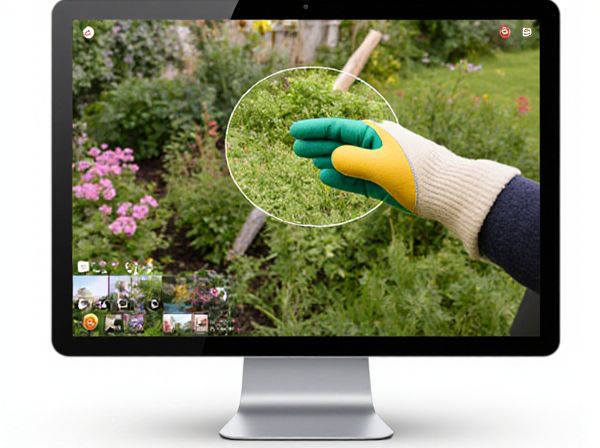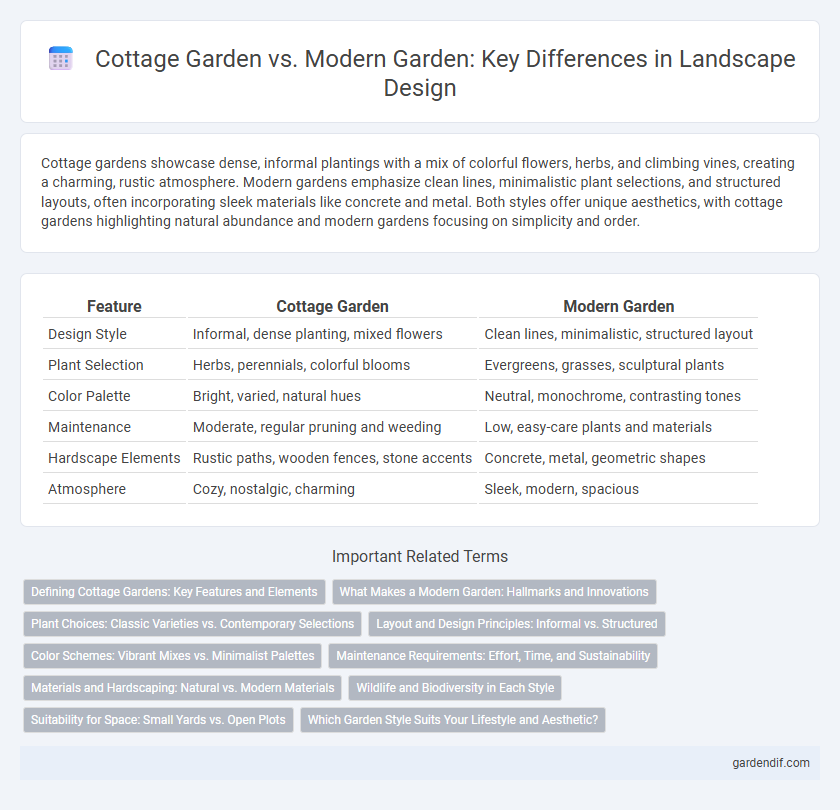
Cottage Garden vs Modern Garden Illustration
Cottage gardens showcase dense, informal plantings with a mix of colorful flowers, herbs, and climbing vines, creating a charming, rustic atmosphere. Modern gardens emphasize clean lines, minimalistic plant selections, and structured layouts, often incorporating sleek materials like concrete and metal. Both styles offer unique aesthetics, with cottage gardens highlighting natural abundance and modern gardens focusing on simplicity and order.
Table of Comparison
| Feature | Cottage Garden | Modern Garden |
|---|---|---|
| Design Style | Informal, dense planting, mixed flowers | Clean lines, minimalistic, structured layout |
| Plant Selection | Herbs, perennials, colorful blooms | Evergreens, grasses, sculptural plants |
| Color Palette | Bright, varied, natural hues | Neutral, monochrome, contrasting tones |
| Maintenance | Moderate, regular pruning and weeding | Low, easy-care plants and materials |
| Hardscape Elements | Rustic paths, wooden fences, stone accents | Concrete, metal, geometric shapes |
| Atmosphere | Cozy, nostalgic, charming | Sleek, modern, spacious |
Defining Cottage Gardens: Key Features and Elements
Cottage gardens are characterized by dense plantings of mixed flowers, herbs, and vegetables that create a natural, informal, and whimsical atmosphere. Key elements include old-fashioned flowers like hollyhocks, foxgloves, and roses, along with climbing plants, herbaceous borders, and winding paths. This garden style emphasizes biodiversity, layered planting, and a charmingly rustic aesthetic, contrasting sharply with the clean lines and minimalism of modern garden design.
What Makes a Modern Garden: Hallmarks and Innovations
Modern garden design emphasizes clean lines, minimalism, and functional spaces, often incorporating materials like concrete, steel, and glass for a sleek appearance. Innovations such as automated irrigation systems, LED landscape lighting, and drought-resistant plant selections highlight its sustainable and tech-savvy nature. Hallmarks include geometric layouts, native or sculpted plants, and outdoor living areas that blend seamlessly with architectural elements.
Plant Choices: Classic Varieties vs. Contemporary Selections
Cottage gardens often feature classic plant varieties such as roses, lavender, hollyhocks, and foxgloves, emphasizing a natural, informal aesthetic with abundant blooms and fragrant herbs. Modern gardens prioritize contemporary selections like ornamental grasses, succulents, and sculptural plants such as agave and echeveria, creating clean lines and minimalist appeal. Plant choices in cottage gardens evoke nostalgia and charm, while modern gardens focus on low-maintenance, drought-resistant species that complement sleek design elements.
Layout and Design Principles: Informal vs. Structured
Cottage gardens feature informal layouts with winding paths, dense planting, and a naturalistic design emphasizing abundance and variety. Modern gardens prioritize structured layouts with clean lines, geometric shapes, and minimalistic planting schemes to create a sense of order and simplicity. The contrasting design principles highlight the charm of organic spontaneity in cottage gardens versus the sleek precision of modern garden aesthetics.
Color Schemes: Vibrant Mixes vs. Minimalist Palettes
Cottage gardens showcase vibrant mixes of colors, blending diverse hues like rich purples, bright pinks, and sunny yellows to create a lively, naturalistic atmosphere. Modern gardens emphasize minimalist palettes, often using monochromatic tones or shades of green with occasional pops of white or gray for a sleek, clean appearance. The choice between these color schemes significantly influences the garden's mood, where cottage gardens evoke warmth and spontaneity, while modern gardens convey simplicity and sophistication.
Maintenance Requirements: Effort, Time, and Sustainability
Cottage gardens demand higher maintenance with frequent pruning, weeding, and seasonal plant care to preserve their dense, informal look, often requiring several hours per week. In contrast, modern gardens emphasize low-maintenance design using drought-resistant plants, synthetic mulches, and automation systems, significantly reducing time and effort while enhancing sustainability. Sustainable practices in modern gardens promote water conservation and soil health, whereas cottage gardens rely more on traditional labor-intensive upkeep.
Materials and Hardscaping: Natural vs. Modern Materials
Cottage gardens emphasize natural materials such as stone, wood, and gravel, creating an organic, rustic aesthetic that blends seamlessly with lush plantings. Modern gardens prioritize sleek, industrial materials like concrete, steel, and composite decking, offering clean lines and minimalist hardscaping elements. The choice of materials directly influences the garden's atmosphere, with natural textures promoting warmth and modern materials highlighting simplicity and structure.
Wildlife and Biodiversity in Each Style
Cottage gardens boast dense plantings of native flowers, herbs, and shrubs that create diverse habitats, attracting pollinators, birds, and beneficial insects, thus enhancing local biodiversity. Modern gardens prioritize sleek design and minimalism, often featuring limited plant variety and hardscapes, which can reduce available wildlife habitats but may incorporate native species to support urban biodiversity. Integrating a variety of flowering plants and natural elements in both styles supports ecosystem health and promotes sustainable wildlife conservation.
Suitability for Space: Small Yards vs. Open Plots
Cottage gardens thrive in small yards, utilizing dense plantings and vertical elements to maximize limited space with a charming, informal aesthetic. Modern gardens suit open plots, emphasizing clean lines, minimalism, and open areas that highlight architecture and structured landscaping. Space adaptability defines their design principles, with cottage gardens prioritizing coziness and modern gardens focusing on spaciousness.
Which Garden Style Suits Your Lifestyle and Aesthetic?
Cottage gardens feature dense, informal plantings with heirloom flowers and rustic decor, ideal for those who prefer a charming, relaxed atmosphere and enjoy hands-on gardening. Modern gardens emphasize clean lines, minimalism, and structured layouts, suited for individuals seeking low-maintenance, contemporary aesthetics that complement urban living. Choosing between these styles depends on your lifestyle preferences, available time for garden care, and the desired visual impact in your outdoor space.
Cottage Garden vs Modern Garden Infographic

 gardendif.com
gardendif.com